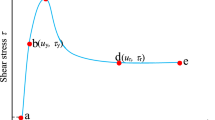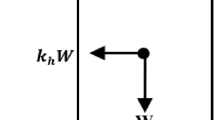Abstract
Numerous studies on the instability and shear strength of expansive soil slopes have suggested that the fundamental reason for shallow sliding failures is insufficient shear strength caused by repeated dry-wet cycles under low stress. Therefore, this paper studied the effects of low stress and dry-wet cycles on the shear strength of expansive soil slopes. A nonlinear curve that can be well fitted using generalized power functions was observed for the shear strength of expansive soil, and a numerical model with nonlinearly distributed shear strength taken into consideration was built using FISH. In this way, the dynamic distribution of shear strength as a function of vertical stress was obtained. Compared to conventional models, the proposed model was more accurate in terms of theoretical aspects, and the obtained results exhibited improved consistency with the actual mode. In order to improve the applicability of this model, a mapping model of atmospheric action and engineering design of safety factors of slopes was established using a Gaussian Process Regression (GPR) model, which is suitable for cases characterized by high dimension, small sample population, and nonlinearity. Herein, the numerical calculations were replaced with output responses. In this way, fast prediction of the stability of expansive soil slopes in terms of a shallow sliding failure prediction model was achieved. To verify the feasibility of the proposed approach, dynamic predictions of shallow sliding failures of expansive soil slopes were carried out for Nanyou Highway under different rainfall conditions. Meanwhile, safety factor responses corresponding to different slope design schemes were also obtained using the proposed model, providing reference for slope stability analysis in expansive soil zones.
Similar content being viewed by others
References
Anthony, T. C. G. and Goh, S. H. (2007). “Support vector machines: Their use in geotechnical engineeirng as illustrated using seismic liquefaction data.” Computers and Geotechnics, Vol. 34, No. 5, pp. 410–421.
Bao, C. G. and Ng, C. W. W. (2000) “Some thoughts and studies on the prediction of slope stability in expansive soils.” In: Proceedings of the Asian Conference on Unsaturated Soils, UNSAT-ASIA, Singapore, pp. 15–31.
Bishop, A. W., Webb, D. L., and Lewin, P. I. (1965). “Undisturbed samples of London Clay from the Ashford Common shaft: Strength effective normal stress relationship.” Geotechnique, Vol. 15, No. 1, pp. 1–31.
Carl Edward Rasmussen, Christopher K I Williams (2006). Gaussian processes for machine learning, Massachusetts. MIT Press.
Chen, S. X. and Chen, S. Y. (2001). “Analysis of stability of unsaturated soil slope due to permeation of rainwater.” Rock and Soil Mechanics, Vol. 22, No. 4, pp. 447–450.
Day, R. W. and Axten, G. W. (1989). “Surficial stability of compacted clay slopes.” Journal of Geotechnical Engineering, Vol. 115, No. 4, pp. 577–580.
Fang, K. T. and Ma, C. X. (2001). Orthogonal and uniform experimental design, Beijing: Science press.
Feng, X. T. (2000). “Introduction to intelligent rock mechanics.” Beijing: Science Press, pp. 239–241.
Kang, F., Han, S. X., Salgado, R., and Li, J. J. (2015). “System probabilistic stability analysis of soil slopes using Gaussian process regression with Latin hypercube sampling.” Computers and Geotechnics, Vol. 63, No. 1, pp. 13–25.
Fredlund, D. G. (1987). “Slope stability analysis incorporating the effect of soil suction. In: Slope Stability. Anderson M. G and Richards K. S Eds.” New York: wiley, pp. 113–144.
Girolami, M. and Rogers, S. (2006). “Variational Bayesian multinomial probit regression with Gaussian process priors.” Neural Computation, Vol. 18, No. 18, pp. 1790–1817.
Huang, R. Q. and Wu, L. Z. (2007). “Stability analysis of unsaturated expansive soil slope.” Earth Science Frontiers, Vol. 14, No. 6, pp. 129–133.
Jarno, V., Jaakko, R., Jouni, H., Pasi, J., Ville, T., and Aki, V. (2013). “GPstuff: Bayesian modeling with gaussian processes.” Journal of Machine Learning Research, Vol. 14, pp. 1175–1179.
Li, S. J., Feng, X. T., and Zhao, H. B. (2004). “Forecast analysis of monitoring data for high slopes based on three-dimensional geological information and intelligent algorithm.” International Journal of Rock Mechanics and Mining Sciences, Vol. 41, No. 3, pp. 519–520.
Li, E. P., Zhuang, X. Y., Zheng, W. b., and Cai, Y. C. (2014). “Effect of graph generation on slope stability analysis based on graph theory.” Journal of Rock Mechanics and Geotechnical Engineering, Vol. 6, pp. 380–386.
Liao, S. W. (1984). Expansive Soil and Railway Engineering, Beijing: China Railway Publishing Press.
Liu, T. H. (1997). Problems Related to Expansive Soil in Engineering Constructions, Beijing: China Architecture and Building Press.
Liu, H. Q. and Yin, Z. Z. (2010). “Research on analytical method of stability of expansive soil slope.” Rock and Soil Mechanics, Vol. 31, No. 5, pp. 1545–1549.
Liu, Z. B., Shao, J. F., Xu, W. Y., Chen, H. J., and Shi, C. (2014). “Comparison on landslide nonlinear displacement analysis and prediction with computational intelligence approaches.” Landslides, Vol. 11, pp. 889–896.
Maksimovic, M. (1989). “Nonlinear failure envelope for soils.” Journal of Geotechnical Engineering, Vol. 115, No. 4, pp. 581–586.
Ovidio, J., Santos, J. R., and Tarcisio, B. C. (2008). “Artificial neural networks analysis of Sao Paulo subway tunnel settlement data.” Tunnelling and Underground Space Technology, Vol. 23, pp. 481–491.
Rabczuk, T. and Areias, P. M. A. (2006). “A new approach for modelling slip lines in geological materials with cohesive models.” International Journal for Numerical and Analytical Methods in Engineering, Vol. 30, No. 11, pp. 1159–1172.
Rasmussen, C. E. and Williams, C. K. I. (2006). Gaussian processes for machine learning, London: The MIT Press.
Rohmer, J. and Foerster, E. (2011). “Global sensitivity analysis of largescale numerical landslide models based on Gaussian-Process metamodeling.” Comput Geosci, Vol. 37, No. 7, pp. 917–927.
Su, G. S., Yan, L. B., and Song, Y. C. (2007). “Gaussian process for nonlinear displacement time series prediction of landslide.” Journal of China University of Geosciences, Vol. 18, pp. 219–222.
Xiao, J., Yang, H. P., Wang, X. Z., and Tang, X. Y. (2014). “Analysis of nonlinear characteristics of shear strength of nanning expansive soil and its influencing factors.” China Journal of Highway and Transpor, Vol. 27, No. 10, pp. 2–7.
Yao, H. L., Zheng, S. H., Li, W. B., and Chen, S. Y. (2002). “Parametric study on the effect of rain infiltration on stability of unstaturated expansive soil slope.” Chinese Journal of Rock Mechanics and Engineering, Vol. 21, No. 7, pp. 1034–1039.
Yang, H. P., Wang, X. Z., and Xiao, J. (2014). “Influence of wettingdrying cycles on strength characteristics of Nanning expansive soils.” Chinese Journal of Geotechnical Engineering, Vol. 36, No. 5, pp. 950–954.
Yin, Z. Z., Yuan, J. P., Wei, J., Cao, X. S., Liu, H. Q., and Xu, B. (2012). “Influences of fissures on slope stability of expansive soil.” Chinese Journal of Geotechnical Engineering, Vol. 34, No. 12, pp. 2155–2161.
Zheng, J. L. and Yang, H. P. (2004). Theory and Practice of Expansive Soil Treatment Technology, Beijing: China Communication Press.
Zheng, J. L. and Yang, H. P. (2009). Expansive Soil Engineering of Highway, Beijing: China Communication Press.
Zheng, W., Zhuang, X., Li, Y., and Cai, Y. (2013). “Graph theory for stability analysis of rock/soil slopes based on numerical manifold method.” Chinese Journal of Geotechnical Engineering, Vol. 35, No. 11, pp. 2045–2052.
Zheng, W. B., Zhuang, X. Y., Tannant, D. D., Cai, Y. C., and Nunoo, S. (2014). “Unified continuum/discontinuum modeling framework for slope stability assessment.” Engineering Geology, Vol. 179, pp. 90–101
Zhou, J., Xu, W., Deng, J., and Liu, X. (2008). “Stability analysis of slope under the condition of rainfall infiltration.” Journal of Hydraulic Engineering, Vol. 39, No. 9, pp. 1066–1073.
Zhuang, X., Cai, Y., Zhu, H., and Zhou, D. (2008). “Rock slope stability analysis based on meshless method and shortest path algorithms.” Chinese Quarterly of Mechanics, Vol. 29, No. 4, pp. 537–543.
Author information
Authors and Affiliations
Corresponding author
Rights and permissions
About this article
Cite this article
He, P., Li, Sc., Xiao, J. et al. Shallow Sliding Failure Prediction Model of Expansive Soil Slope based on Gaussian Process Theory and Its Engineering Application. KSCE J Civ Eng 22, 1709–1719 (2018). https://doi.org/10.1007/s12205-017-1934-6
Received:
Revised:
Accepted:
Published:
Issue Date:
DOI: https://doi.org/10.1007/s12205-017-1934-6




